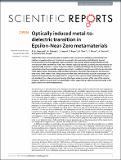Files in this item
Optically induced metal-to-dielectric transition in Epsilon-Near-Zero metamaterials
Item metadata
| dc.contributor.author | Kaipurath, R M | |
| dc.contributor.author | Pietrzyk, Monika | |
| dc.contributor.author | Caspani, L | |
| dc.contributor.author | Roger, T | |
| dc.contributor.author | Clerici, M | |
| dc.contributor.author | Rizza, C | |
| dc.contributor.author | Ciattoni, A | |
| dc.contributor.author | Di Falco, Andrea | |
| dc.contributor.author | Faccio, F | |
| dc.date.accessioned | 2016-06-16T10:30:04Z | |
| dc.date.available | 2016-06-16T10:30:04Z | |
| dc.date.issued | 2016-06-13 | |
| dc.identifier | 242995185 | |
| dc.identifier | a7eba0cd-e1b2-4d18-9f24-10ed1526fca9 | |
| dc.identifier | 84974822879 | |
| dc.identifier | 000378033500001 | |
| dc.identifier.citation | Kaipurath , R M , Pietrzyk , M , Caspani , L , Roger , T , Clerici , M , Rizza , C , Ciattoni , A , Di Falco , A & Faccio , F 2016 , ' Optically induced metal-to-dielectric transition in Epsilon-Near-Zero metamaterials ' , Scientific Reports , vol. 6 , 27700 . https://doi.org/10.1038/srep27700 | en |
| dc.identifier.issn | 2045-2322 | |
| dc.identifier.other | ORCID: /0000-0002-7338-8785/work/57821786 | |
| dc.identifier.uri | https://hdl.handle.net/10023/8998 | |
| dc.description | This work was supported by the EPSRC grant EP/ J004200/1. D.F. acknowledges financial support from the European Research Council under the European Union Seventh Framework Programme (FP/2007-2013)/ERC GA 306559 and EPSRC (UK, Grant No. EP/J00443X/1). L.C. and M.C. acknowledge the support from the People Programme (Marie Curie Actions) of the European Union’s FP7 Programme THREEPLE (GA 627478) and KOHERENT (GA 299522). A.C. and C.R. acknowledge support from U.S. Army International Technology Center Atlantic for financial support (Grant No. W911NF-14-1-0315). | en |
| dc.description.abstract | Epsilon-Near-Zero materials exhibit a transition in the real part of the dielectric permittivity from positive to negative value as a function of wavelength. Here we study metal-dielectric layered metamaterials in the homogenised regime (each layer has strongly subwavelength thickness) with zero real part of the permittivity in the near-infrared region. By optically pumping the metamaterial we experimentally show that close to the Epsilon-Near-Zero (ENZ) wavelength the permittivity exhibits a marked transition from metallic (negative permittivity) to dielectric (positive permittivity) as a function of the optical power. Remarkably, this transition is linear as a function of pump power and occurs on time scales of the order of the 100 fs pump pulse that need not be tuned to a specific wavelength. The linearity of the permittivity increase allows us to express the response of the metamaterial in terms of a standard third order optical nonlinearity: this shows a clear inversion of the roles of the real and imaginary parts in crossing the ENZ wavelength, further supporting an optically induced change in the physical behaviour of the metamaterial. | |
| dc.format.extent | 7 | |
| dc.format.extent | 625696 | |
| dc.language.iso | eng | |
| dc.relation.ispartof | Scientific Reports | en |
| dc.subject | QB Astronomy | en |
| dc.subject | QC Physics | en |
| dc.subject | TP Chemical technology | en |
| dc.subject | DAS | en |
| dc.subject.lcc | QB | en |
| dc.subject.lcc | QC | en |
| dc.subject.lcc | TP | en |
| dc.title | Optically induced metal-to-dielectric transition in Epsilon-Near-Zero metamaterials | en |
| dc.type | Journal article | en |
| dc.contributor.sponsor | EPSRC | en |
| dc.contributor.institution | University of St Andrews. School of Physics and Astronomy | en |
| dc.identifier.doi | 10.1038/srep27700 | |
| dc.description.status | Peer reviewed | en |
| dc.identifier.grantnumber | EP/J004200/1 | en |
This item appears in the following Collection(s)
Items in the St Andrews Research Repository are protected by copyright, with all rights reserved, unless otherwise indicated.

